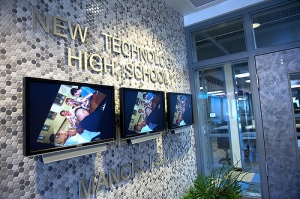
A sea-change in high school curriculum is occurring. It’s happening because of an ever-changing Digital Age and a critical need for highly skilled technology workers. While elected leaders debate common core issues, collaborative efforts between public-sector educators and private-sector employers are resulting in major initiatives to enhance technology workforce training throughout the country. The changes cannot come too quickly if the U.S. is to retain its position as a global leader.

Photo by Marco Antonio Torres licensed under CC BY 2.0.
Community colleges nationwide have traditionally provided workforce training to meet technology needs and collaboration with industry was common. Courses offered were suggested and usually designed by regional employers. But as the gap widened between technology job openings and trained workers to fill them, education experts and private employers began working together to focus their efforts at the high school level to help close the technology gap.
The Florida Legislature debated a bill during this year’s legislative session that would allow high school students to take computer-coding classes in lieu of foreign language graduation requirements. A technology executive first promoted the change. Although it did not pass, if the legislation had become law, institutions and state universities in the Florida College System would have accepted coding credits as a replacement for foreign language credits. Students would have been allowed to take classes at their school or through the Florida Virtual School program. This is a trend that may emerge in time.
As early as 2007, a new technology-based high school called Manor New Technology High School opened in Manor, near Austin. The school prepares students for careers in the fields of science, technology, engineering and mathematics (STEM). Recognizing the importance of STEM skills, the school’s technology curriculum focuses on what has become the new norm – technology-based, student-centered learning. The Manor school has received national attention and President Barack Obama, during an on-site visit to the campus in 2013, commended the collaboration that resulted in offering unique new opportunities to students.
Elsewhere in Texas, the Longview ISD Board of Trustees recently met with representatives of the district’s educational departments to discuss educational goals for 2016. One of the first objectives discussed was how to prepare students both for the workforce and for college.
In Colorado, lawmakers recently considered a package of bills stressing collaborative efforts between employers and educators. The bills under consideration were all centered on providing good-paying jobs for individuals while also developing technology talent for employers in Colorado. One bill would have provided bonuses for school districts that provide “rigorous” workplace training that meets the needs of specific industries. It also included grants for tuition, fees, books and other related costs for public school teachers seeking additional education that would enable them to teach computer science courses.
Almost every state faces a shortage of workers for technology jobs. Colorado’s nearly 16,000 computer programming job openings are three times the national average. These jobs pay an average annual salary of about $92,000, yet only one in four high schools in Colorado teach computer programming. Most other states have a similar problem.
Schools in the Chicago area are being reinvented and tech firms are working with educators to make changes. Five public high schools are getting customized curriculum that will prepare students for technology careers. Corporations in Brooklyn are also involved in helping a high school develop technology-related curriculum.
Technology now drives almost every aspect of economic prosperity – for individuals, industry, communities and the world. The workplace has become so technology-centric that it is critically important to make dramatic shifts in educational offerings. How sweet it is to see educators and industry leaders collaborate to ensure that students are offered courses that prepare them for the most competitive workplace the world has ever experienced!
SPI’s newsletters are excellent sources of information for public sector procurement news. Subscribe today.
